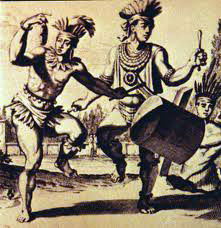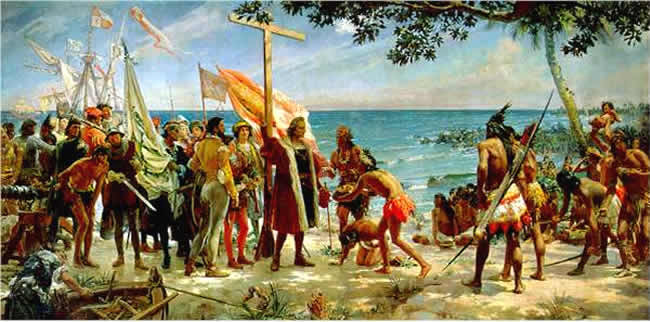If you need an overview/review of the Haitian Revolution, watch the video linked below.
Change the speed to .75 to slow it down because the guy talks really fast.
Click here to see the video.
Tuesday, October 22, 2019
Tuesday, October 1, 2019
Taino Artifacts
Artifact 1: Image of Taíno women preparing cassava bread.
Artifact 2: Images of Taíno canoes
Artifact 4: Image and description of an Areítos
 Areítos were held for a variety of reasons, including to honor and entertain guests. In the early days of European colonization, Taíno chiefs hosted areítos for Spanish visitors, who recorded information about the ceremonies. According to the historical documentation, areítos often featured assemblies of nobles dancing and singing to music played with rattles and drums. The ceremonies invoked elements of Taíno culture and religious practice, including veneration of ancestors. Areítos were held in designated spaces, specifically the public plaza or dance ground outside the chief's house. Classic Taíno villages often featured an elaborate dance court.
Areítos were held for a variety of reasons, including to honor and entertain guests. In the early days of European colonization, Taíno chiefs hosted areítos for Spanish visitors, who recorded information about the ceremonies. According to the historical documentation, areítos often featured assemblies of nobles dancing and singing to music played with rattles and drums. The ceremonies invoked elements of Taíno culture and religious practice, including veneration of ancestors. Areítos were held in designated spaces, specifically the public plaza or dance ground outside the chief's house. Classic Taíno villages often featured an elaborate dance court.
Artifact 5: Painting of the first encounter between Columbus and the Taíno
Artifact 2: Images of Taíno canoes
Artifact 3: Journal Entry from Columbus's diary
Monday, October 15. And while I was between these two islands, i.e., Santa María and this large one which I named Fernandina, I met a man alone in a canoe going from the island of Santa María to Fernandina. He had with him a small loaf, the size of his fist, a gourd of water, some red earth ground into powder and made into paste, and some dried leaves, which these people must greatly prize, for they presented me some of it on San Salvador. He had also a basket made in their native fashion in which he had a small string of glass beads and two [Spanish coins]. From these things I knew that he had come from the island of San Salvador, had touched Santa María, and was now going to Fernandina.
Artifact 4: Image and description of an Areítos
 Areítos were held for a variety of reasons, including to honor and entertain guests. In the early days of European colonization, Taíno chiefs hosted areítos for Spanish visitors, who recorded information about the ceremonies. According to the historical documentation, areítos often featured assemblies of nobles dancing and singing to music played with rattles and drums. The ceremonies invoked elements of Taíno culture and religious practice, including veneration of ancestors. Areítos were held in designated spaces, specifically the public plaza or dance ground outside the chief's house. Classic Taíno villages often featured an elaborate dance court.
Areítos were held for a variety of reasons, including to honor and entertain guests. In the early days of European colonization, Taíno chiefs hosted areítos for Spanish visitors, who recorded information about the ceremonies. According to the historical documentation, areítos often featured assemblies of nobles dancing and singing to music played with rattles and drums. The ceremonies invoked elements of Taíno culture and religious practice, including veneration of ancestors. Areítos were held in designated spaces, specifically the public plaza or dance ground outside the chief's house. Classic Taíno villages often featured an elaborate dance court.Artifact 5: Painting of the first encounter between Columbus and the Taíno
Subscribe to:
Posts (Atom)




